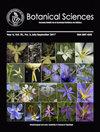Chemical constituents of Salvia urica Epling, and their antihyperglycemic and antipropulsive effects
IF 0.7
4区 生物学
Q3 PLANT SCIENCES
引用次数: 0
Abstract
Background: Salvia urica Epling is taxonomically and phylogenetically related to Salvia amarissima Ortega. The last species has pharmacological relevance by its contents of bioactive metabolites. Nowadays, Salvia urica has no reports about its chemical constituents and pharmacological activities. Hypothesis: Does the close relationship between S. amarissima and S. urica led both species produce similar specialized metabolites? Does Salvia urica display similar pharmacological effects as S. amarissima? Studied species: Salvia urica Epling (Lamiaceae). Study site and dates: The plant material was collected in Teopisca, Chiapas, Mexico, in December 2021. Methods: Metabolites of the acetone extract from Salvia urica were identified by GC-MS and HPLC-PDA profiling. In parallel, a phytochemical study was conducted, and the individual purified constituents, previously characterized by 1D NMR, were assayed on antihyperglycemic effect in diabetic mice and a charcoal-gum arabic-induced hyperperistalsis model in rats. Results: The volatile compounds identified by GC-MS were alkanes, aromatics and triterpenes. The principal constituents of the acetone extract of Salvia urica were amarissinin A and 5,6-dihydroxy-7,3',4'-trimethoxyflavone, which were also quantified by HPLC-PDA. The extract and both metabolites isolated showed an antihyperglycemic effect on streptozotocin-induced diabetic mice, suggesting a possible synergic effect. In addition, the compound 5,6-dihydroxy-7,3',4'-trimethoxyflavone (IC50 = 0.79 mg/kg) showed a better antipropulsive effect than loperamide (IC50 = 16.6 mg/kg). Conclusions: The phytochemical composition of an acetone extract of Salvia urica was determined by first time. The metabolites isolated from this plant support the phylogenetic relationship of S. urica with Salvia amarissima, and they showed antipropulsive and antihyperglycemic effects.丹参的化学成分及其降血糖和抗惊厥作用
背景:Salvia urica Epling 在分类学和系统发育上与 Salvia amarissima Ortega 相关。最后一个物种含有生物活性代谢物,具有药理学意义。目前,还没有关于丹参化学成分和药理活性的报道。 假设S. amarissima 和 S. urica 之间的密切关系是否导致这两个物种产生类似的特殊代谢物?丹参是否具有与 S. amarissima 类似的药理作用? 研究物种:Salvia urica Epling(唇形科)。 研究地点和日期:植物材料于 2021 年 12 月在墨西哥恰帕斯州 Teopisca 采集。 研究方法通过 GC-MS 和 HPLC-PDA 分析鉴定了丹参丙酮提取物中的代谢物。与此同时,还进行了植物化学研究,并对先前通过一维核磁共振鉴定的各个纯化成分在糖尿病小鼠和木炭-阿拉伯胶诱导的大鼠高胃肠蠕动模型中的降血糖效果进行了检测。 结果:经 GC-MS 鉴定的挥发性化合物有烷烃、芳香族和三萜类。丹参丙酮提取物的主要成分是丹参素 A 和 5,6-二羟基-7,3',4'-三甲氧基黄酮,这两种物质也通过 HPLC-PDA 进行了定量。提取物和分离出的两种代谢物对链脲佐菌素诱导的糖尿病小鼠都有降血糖作用,这表明可能存在协同作用。此外,化合物 5,6-二羟基-7,3',4'-三甲氧基黄酮(IC50 = 0.79 毫克/千克)比洛哌丁胺(IC50 = 16.6 毫克/千克)具有更好的抑制作用。 结论首次测定了丹参丙酮提取物的植物化学成分。从丹参中分离出的代谢物支持了丹参与鼠尾草的系统发育关系,并具有抗惊厥和降血糖作用。
本文章由计算机程序翻译,如有差异,请以英文原文为准。
求助全文
约1分钟内获得全文
求助全文
来源期刊

Botanical Sciences
Agricultural and Biological Sciences-Plant Science
CiteScore
1.90
自引率
21.40%
发文量
71
审稿时长
16 weeks
期刊介绍:
Botanical Sciences welcomes contributions that present original, previously unpublished results in Botany, including disciplines such as ecology and evolution, structure and function, systematics and taxonomy, in addition to other areas related to the study of plants. Research reviews are also accepted if they summarize recent advances in a subject, discipline, area, or developmental trend of botany; these should include an analytical, critical, and interpretative approach to a specific topic. Acceptance for reviews will be evaluated first by the Review Editor. Opinion Notes and Book Reviews are also published as long as a relevant contribution in the study of Botany is explained and supported.
 求助内容:
求助内容: 应助结果提醒方式:
应助结果提醒方式:


